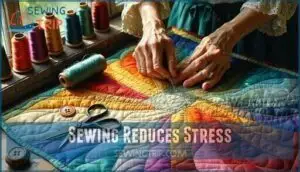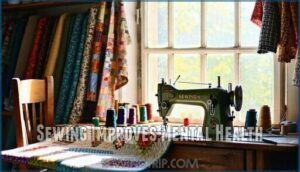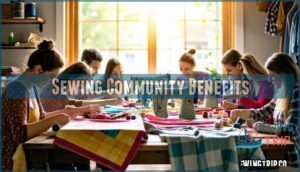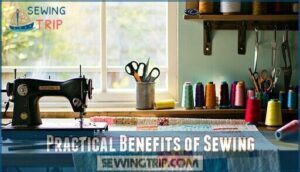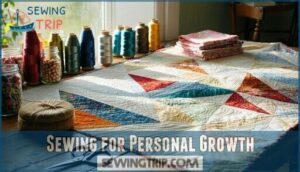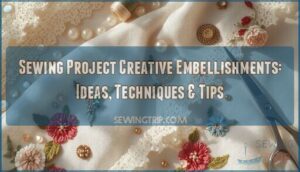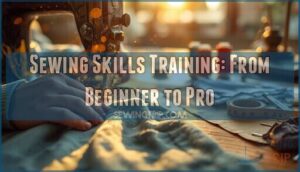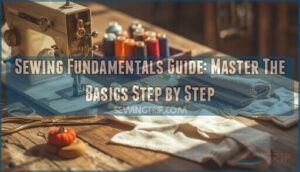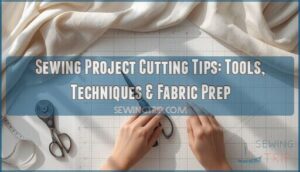This site is supported by our readers. We may earn a commission, at no cost to you, if you purchase through links.
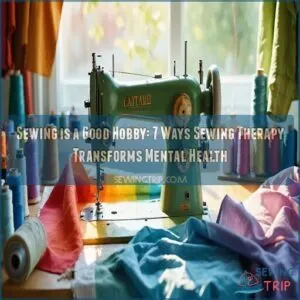
When you’re threading a needle or guiding fabric through your machine, your mind quiets down and stress melts away.
Your hands stay busy while your brain releases feel-good chemicals, creating a natural antidote to anxiety.
Many sewists describe entering a "flow state" where time seems to stop—it’s like meditation with tangible results!
You’re not just creating something beautiful; you’re also stitching together better mental health.
The repetitive motion creates a rhythm that soothes your nervous system, and there’s nothing quite like the satisfaction of wearing something you’ve made yourself.
Table Of Contents
Key Takeaways
- You’ll experience stress reduction when sewing, as the rhythmic motion creates a meditative state that slows your heart rate, releases dopamine, and calms your nervous system.
- You’ll build confidence and self-esteem with each completed project, turning challenges into achievements while developing problem-solving skills and patience.
- You’ll benefit from social connections by joining sewing communities that offer support, skill-sharing opportunities, and meaningful friendships with like-minded people.
- You’ll save money while expressing creativity through customized clothing, home décor, and gifts that perfectly fit your style and preferences.
Sewing Reduces Stress
When you’re feeling overwhelmed, threading a needle and focusing on each stitch can pull your mind away from daily worries.
You’ll notice your heart rate slowing down and your shoulders relaxing as your hands create something beautiful, giving your busy brain a much-needed break from life’s chaos.
Here’s a short, engaging blockquote that captures the same tone as the paragraph you shared:
Each stitch is a whisper to your nervous system: slow down, breathe, create beauty from chaos.
Mindfulness and Relaxation
Sewing’s rhythmic cadence provides a natural gateway to mindfulness and relaxation. As you focus on each stitch, you’re anchored in the present moment, creating a meditative state that calms both mind and body.
- Your breathing naturally syncs with your stitching pattern, creating a relaxation technique similar to yoga
- The tactile sensory awareness of fabric textures melts away daily stress
- Time seems to stand still, offering a rare escape from life’s constant demands
- Your racing thoughts quiet down, replaced by emotional balance and creative flow
Practicing sewing can lead to increased mindful awareness, which fosters a state of relaxation and promotes creative flow.
Dopamine Release and Happiness
When you thread your needle and start creating, your brain releases dopamine—nature’s own "happy chemical."
This natural antidepressant floods your system during joyful crafting, creating what many call "sewing euphoria."
Your hobby happiness isn’t just imagination; it’s biochemistry at work!
Each stitch, pattern selection, and creative decision triggers this feel-good neurotransmitter, transforming your mental health.
Sewing therapy offers profound benefits beyond the physical project—it’s literally rewiring your brain for happiness.
Calming Effect on Physical Health
The physical benefits from sitting down with your needle and thread extend well beyond mental calmness.
When you engage in sewing therapy, your body responds with measurable health improvements:
- Your heartbeat slows by up to 11 beats per minute and blood pressure drops
- Digestion improvement occurs as your body enters a relaxation response
- Better sleep and reduced pain follow as mindfulness practices release physical tension
Sewing Improves Mental Health
You’ll find that threading a needle can actually thread together your frazzled thoughts, as sewing releases mood-boosting dopamine while giving you a safe space to process emotions.
When you’re feeling overwhelmed, your sewing machine can become your therapist’s couch, helping you stitch away anxiety and piece together improved mental well-being with every project you complete, which ultimately leads to enhanced mental well-being.
Therapy for Anxiety and Depression
The needle’s rhythmic movement offers profound therapy for anxiety and depression sufferers.
The gentle rhythm of sewing calms the mind, turning anxious thoughts into threads of peace and creativity.
When your mind races with worry, sewing redirects your focus, creating a meditative effect that calms anxieties.
| Sewing Therapy Benefits | Impact on Mental Health |
|---|---|
| Emotional Release | Provides safe outlet for feelings |
| Refocusing Attention | Redirects from negative thoughts |
| Meditative Effects | Creates calming mindfulness |
| Trauma Processing | Allows non-verbal expression |
| Anxiety Relief | Reduces stress hormones |
Healthcare professionals increasingly recommend sewing therapy as a complementary treatment for depression and anxiety disorders.
Many find it to be a good way to implement self-management strategies for their mental health, providing a safe outlet for feelings and helping to redirect from negative thoughts. Sewing therapy allows for non-verbal expression and can be a powerful tool in reducing stress hormones. By creating a meditative effect, sewing can help individuals process their emotions and find calming mindfulness.
Processing Emotions Through Crafting
The gentle rhythm of crafting creates a unique safe space for emotional release. When words fail, your hands can express what’s difficult to say through sewing therapy.
Sewing can also act as complementary mental therapy.
- Repetitive stitching helps identify feelings buried beneath the surface
- Creating tangible objects provides a physical representation of emotional processing
- Threading needles requires focus, naturally directing attention away from trauma
- Fabric choice becomes a non-verbal expression of your internal state
Boosting Mood and Self-Esteem
Sewing’s impact on your mood is truly transformative.
When you create something with your hands, you’ll experience a natural mood boost that enhances self-esteem.
Creative expression through sewing therapy allows you to develop personal style while practicing self-acceptance.
The finished projects become positive affirmations of your abilities.
Many sewists report improved mental health and selfconfidence, especially when projects reflect their body positivity journey.
You’re not just making clothes—you’re crafting a better relationship with yourself.
Sewing Community Benefits
You’ll find a special kind of magic when you join sewing communities, where friendly faces share tips while celebrating your victories (even that slightly crooked first zipper).
Whether you connect at local fabric shops or through online forums, you’ll build lasting friendships while expanding your skills in a supportive environment that turns solo stitching into a shared journey of creativity.
Social Connections and Support
While enhancing your mental well-being, sewing also opens doors to meaningful social connections.
You’ll find likeminded people in local sewing circles and online sewing groups who understand your passion.
The sewing community offers more than just skill sharing—it provides friendship, encouragement, and belonging.
Whether you’re collaborating on projects or simply socializing with fellow enthusiasts, these community bonds create a supportive network that enhances your creative journey.
Learning and Skill-Building
The beauty of sewing lies in its endless learning curve.
You’ll start with basic stitches but soon find yourself tackling complex projects that once seemed impossible.
Each pattern interpretation builds your confidence, while sewing tutorials guide your skill progression.
Don’t be afraid to experiment creatively – mistakes are just growth opportunities!
Whether you’re a beginner mastering straight seams or an expert exploring advanced techniques, sewing’s journey of technique mastery never truly ends.
Sewing also allows you to experience significant stress relief through its mindful practice.
Sustainable Practices and Environmental Awareness
Beyond learning new skills, your sewing hobby helps heal our planet.
You’ll join a community that champions sustainable practices—from choosing eco-friendly fabrics to embracing zero-waste sewing patterns.
By upcycling clothing and repairing beloved garments, you’re quietly rebelling against fast fashion.
Your sustainable wardrobe becomes a statement of ethical fashion values, and you’ll find satisfaction knowing each stitch contributes to a healthier environment.
It’s slow fashion with a big impact!
Practical Benefits of Sewing
You’ll find that sewing isn’t just good for your mind, but also for your wallet and wardrobe as you create useful items that express your unique style.
From mending that favorite shirt with the stubborn hole to crafting one-of-a-kind pieces nobody else will have, your growing skills transform simple fabric into practical treasures you can proudly use every day.
Creating Useful Items and Saving Money
Through your sewing machine, you can transform scraps into savings.
Handmade gifts and upcycling projects reduce clothing costs and also create meaning from material.
Repairing clothes extends their life while home decor sewing adds personality without breaking the bank.
Sewing your stash, for example, can help you avoid impulse fabric buys.
By investing in fabric for specific DIY projects rather than buying ready-made items, you’ll build a collection of useful, personalized creations that would cost much more in stores and provide a sense of accomplishment from creating something with your own hands, which is a valuable investment.
Customizing Outfits and Expressing Creativity
The joy of transforming plain fabric into something uniquely yours is where sewing truly shines.
You’ll discover endless possibilities for expressing your personal style through DIY fashion and wardrobe remixes.
Custom-fitted clothes can showcase your personality in ways store-bought items never could.
Sewing allows for pattern size adjustments, ensuring a perfect fit.
This is where the true value of sewing lies, in creating something that is tailored to your needs and preferences.
- Feel the rush of pride when someone asks "Where did you get that?" and you reply "I made it!"
- Experience the freedom of creating clothes that perfectly fit YOUR body, not some designer’s idea of "standard" sizing
- Enjoy the therapeutic flow state when your creative vision comes to life through fabric selection and sewing patterns
Developing New Talents and Skills
The needle becomes your teacher as you set out on a sewing journey that builds far more than garments.
You’ll develop pattern adaptation abilities and creative problem-solving skills with each project. As you progress, you’ll notice technique mastery developing naturally.
The beauty of sewing for beginners lies in skill diversification – starting with simple projects then gradually increasing project complexity, turning threads of curiosity into tapestries of accomplishment.
Starting out requires a suitable sewing beginner’s kit.
Sewing for Personal Growth
You’ll find that every stitch you sew builds not just a garment, but also your confidence and sense of purpose.
With each project you complete, you’re quietly transforming yourself, turning challenges into achievements that remind you of your incredible capacity to grow and create.
Building Confidence and Self-Esteem
Every stitch you make in fabric adds a thread of confidence to your own self-worth. After creating useful items, you’ll notice your selfesteem blossoming through personal accomplishment in sewing therapy.
Here’s how sewing builds your confidence:
- Completing projects provides tangible proof of your abilities
- Mastering new techniques reinforces skill mastery
- Wearing self-made clothing encourages body positivity
- Creative expression validates your unique vision
- Receiving compliments on your work strengthens self-acceptance
That pride you feel? You earned it!
Overcoming Challenges and Achieving Success
As your confidence grows, you’ll face new sewing challenges that test your limits.
When you tackle a difficult pattern or fix a stubborn mistake, you’re building valuable problem-solving skills.
Sewing therapy teaches patience through project completion—each finished piece represents an obstacle overcome.
Try celebrating small milestones in your sewing journey; they’re stepping stones to mastery.
Many sewists find creative solutions become natural coping mechanisms, transforming frustration into satisfaction through sewing for mental wellbeing.
Fostering a Sense of Purpose and Fulfillment
In the midst of daily chaos, sewing anchors you to something meaningful.
When you set goals for skill mastery, each completed project becomes a reflection of your growth.
Sewing therapy transforms simple fabric into expressions of your creativity while building self-worth.
Sewing can also provide significant stress relief through mindful stitching and repetitive motion.
Whether you’re crafting a personal legacy through quilts or finding fulfillment in meaningful projects, sewing benefits extend beyond the finished piece—they stitch purpose into your life’s fabric.
Frequently Asked Questions (FAQs)
Why is sewing so therapeutic?
Who needs a therapist when you’ve got a needle and thread?
You’ll find sewing creates mindfulness, releases dopamine for mood boosting, and gives you a sense of accomplishment as stress melts away with each stitch.
Is sewing a healthy hobby?
Sewing is absolutely a healthy hobby!
It boosts your mood, sharpens focus, and even lowers stress.
Plus, creating something with your hands feels amazing—like a mini victory every time.
Who doesn’t love that?
How can sewing help emotionally?
When you’re feeling stressed or anxious, stitching can be your emotional anchor.
You’ll release dopamine while creating, experience mindfulness with each stitch.
You’ll connect with supportive communities that celebrate your creative journey together.
Why is sewing good for your brain?
A study found sewing lowers your heartbeat by 11 beats per minute.
Your brain thrives on the focused attention, releasing dopamine that improves mood while enhancing cognitive skills and memory through pattern recognition.
What are the different techniques used in sewing?
You’ll master basic stitches like running and backstitch, plus fancy techniques including French seams, zippers, and buttonholes.
Don’t forget finishing touches—bias binding, darts, and pleats—that’ll turn your homemade creations into professional masterpieces!
What materials are necessary for sewing?
You’ll need basic supplies including needles, thread, fabric scissors, pins, measuring tape, and fabric. Consider adding a sewing machine, iron, seam ripper, and marking tools to make your projects easier.
How much time does it take to learn the basics of sewing?
Rome wasn’t built in a day!
You’ll learn basic sewing in 10-20 hours spread over a few weeks.
With consistent practice, you’ll master simple stitches, threading, and pattern reading fairly quickly.
How to start sewing with limited space?
Choose a compact sewing machine, use foldable tables, and store supplies in hanging organizers.
You’ll be surprised how little space you actually need—even a closet corner can become your creative haven!
Can sewing help with chronic pain management?
Yes, sewing can help manage chronic pain by distracting your mind, releasing dopamine, and promoting relaxation.
You’ll find the repetitive motions and focused attention create a meditative state that can temporarily reduce pain awareness.
Is hand sewing as beneficial as machine sewing?
Both hand sewing and machine sewing offer a gentle embrace for your well-being.
Hand sewing provides deeper mindfulness and portability, while machine sewing gives quicker results and less physical strain.
You’ll benefit from either approach, as both methods have their unique advantages that promote your overall well-being.
Conclusion
Ultimately, sewing is a good hobby that wraps you in a blanket of calm while creating something beautiful.
You’ll find that sewing therapy offers a thread that connects mind and hands, reducing stress while building confidence.
Whether you’re stitching solo or sharing with others, you’re crafting more than fabric projects—you’re designing better mental health.
So pick up that needle, thread your machine, and watch as your anxiety unravels stitch by satisfying stitch.

